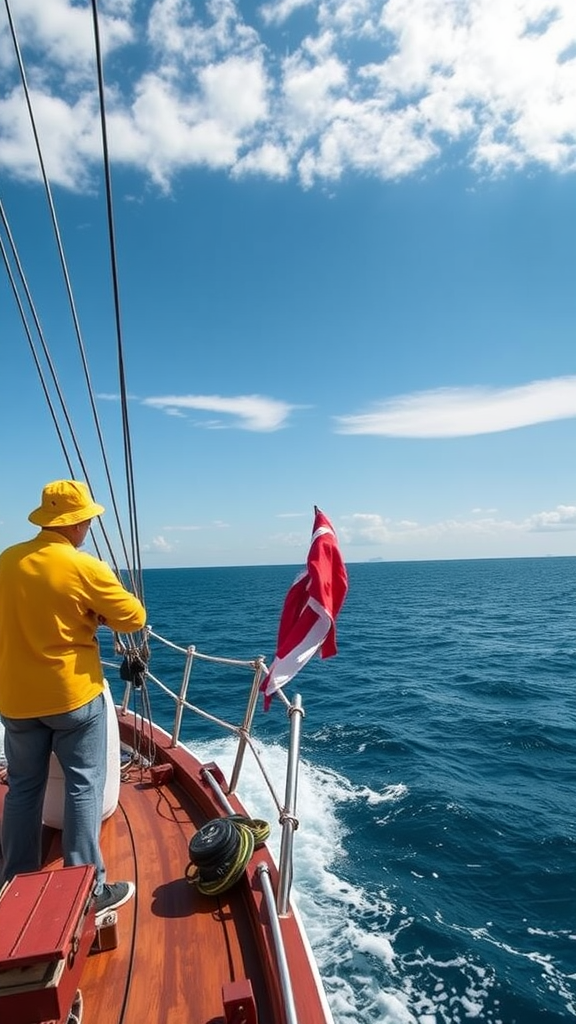Problem Solving at Sea: Strategies for a Successful Pacific Crossing
- Exploring the Pacific Ocean can be the most memorable thing to do. This expedition not only lets you experience the delight of sailing but also helps you learn uncharted skills. Of course, while swimming in the wide watery blue, you will face many challenges of a problem-solving nature. The loading of problems needs analytical solutions. Hence, whether you are experienced or new to it, preparedness for various options is a must.
Gaining Knowledge of Your Technology
Your boat is your reliance to the seafaring world, and knowing it is the first step to solving the problems that arise. Do the following:
- Navigation instruments: Know how to use the GPS, charts, and compass effectively.
- Safety equipment: Ensure life rafts, flares, and first aid kits are onboard and in good condition.
- Engine and sails: Regularly inspect and maintain these components to avoid unexpected breakdowns.
Fulfilling the Weather Commander
Being a sailor on the Pacific, one should constantly watch for the ocean’s fickle weather. Mastering weather science is your ticket to solving problems before they ever arise. Here are some methods:
- Check forecasts: Use reliable weather apps and stay updated on local forecasts.
- Learn to read clouds: Different types of clouds can indicate changes in weather, such as storms.
- Adjust your route: Don’t hesitate to change your course based on weather warnings.
Strategic Communication
While navigating such extensive waters, communication becomes crucial for maintaining safety and order among the crew. Use these skills:
- Set clear roles: Each crew member should know their responsibilities to reduce confusion.
- Regular check-ins: Establish a schedule to confirm everyone is secure and alert.
- Use technology wisely: Radios and satellite phones are your best friends—make sure they are always within reach.
Problem-Solving Techniques
Difficulties will come, from negotiating turbulent seas to technical problems. Arm yourself with a pouch of problem-solving techniques:
- Stay calm: Panic leads to poor decisions. Take a breath and assess the situation.
- Collaborate: Involve your crew in troubleshooting; two (or more) heads are better than one.
- Prioritize safety: Remain focused on safety first, whether it involves securing the boat or helping a crew member in distress.
- Think laterally: Sometimes the simplest solutions can offer new perspectives on a problem. Explore unconventional options.
Strategy and Preparedness
Strategies around the waters subsequent to survival are central as they build the experience:
- Conduct drills: Regularly practice emergency procedures with your crew so everyone knows what to do when the unexpected happens.
- Pack appropriately: Bring enough supplies, such as food, water, and tools specific to your route.
- Plan your stops: Identify safe points along the way to rest or seek shelter if conditions turn bad.
Learning Through Experience
Every sailing passage is an opportunity for growth. Reflecting on your journey helps refine future trips:
- Log your journey: Keep a detailed logbook of encounters and decisions for future reference.
- Discuss with your crew: Conduct debriefing sessions to share perspectives and gather insights about what worked and what didn’t.
- Stay adaptive: The ocean is always changing, and your approach should evolve based on your experiences.
Emerging Flexibility When Encountering Adventures of Sailing an Ocean
An ocean voyage can easily be one of the most interesting things in life. At the same time, though, a lot of unexpected situations will arise that will test your skills and adaptability. Whether you happen to be an experienced seafarer or a neophyte sailor, learning how to tackle these obstacles is a fundamental part of the excursion. The wide expanse of water can throw curveballs—be it sudden weather changes, equipment failure, or navigating unfamiliar waters. Here’s how to adapt and thrive amid these challenges.
Be Flexible
You cannot miss being flexible on your toolkit for ocean voyages. The weather conditions may be volatile, so the ability to make a plan change may be what could save the day. Here are some ways to embrace flexibility:
- Constant Awareness: Always keep an eye on weather forecasts, sea conditions, and other real-time factors that may require you to change your course.
- Alternative Plans: Have backup routes ready. In case of unfavorable winds or storms, knowing where else you can go will save time and stress.
- Mindset Shift: Instead of viewing changes as setbacks, see them as new opportunities. Sometimes the best adventures happen when things don’t go as planned.
Troubleshoot Your Gear
Your boat is your lifeline in the water, thus if it has any deficiencies, fixing them might just delay solving the problem. You can carry out frequent upkeep to prevent unexpected breakdowns. Some practical hints include:
- Check Your Gear: Frequent inspections of sails, rigging, and the hull will help spot issues before they escalate.
- Spare Parts: Carry spare parts for critical equipment like the engine and navigation tools. This small preparation step can prevent a minor issue from becoming a major crisis.
- Communication Devices: Ensure your communication devices are functioning. Keeping in touch with others can be invaluable when you face challenges.
Ensure Good Problem-Solving Standards
A collected mindset and a sound approach are what it takes when something goes out of gear. Problem-solving is a skill that you can develop through effort and learning. Here are several ideas to empower these skills:
- Practice Scenarios: While sailing, simulate challenges with your crew. This practice will prepare you for real-life situations and enhance teamwork.
- Stay Organized: An organized approach to challenges helps in maintaining clarity. Break down problems into manageable parts to work through them effectively.
- Stay Informed: Equip yourself with knowledge about sailing practices, first aid, and emergency protocols.
Teamwork and Communication
Coping with tough situations often needs powerful teamwork. Here’s how it works on board:
- Regular Meetings: Hold daily briefings with your crew to discuss plans, weather updates, and any potential challenges ahead.
- Encourage Open Dialogue: Create a culture where crew members feel comfortable sharing their concerns or ideas. Diverse perspectives can lead to innovative solutions.
- Assign Clear Roles: When crises arise, clarity in roles allows everyone to focus on their responsibilities, reducing chaos and confusion.
Stay Calm and Positive
A person’s mindset has a major role in how one handles challenges. Staying even-headed can give you clearer thinking and better decisions. Here are tips to help you keep your composure:
- Breathing Exercises: Simple breathing techniques can reduce stress and keep your mind clear.
- Positive Affirmations: Remind yourself of your abilities and past successes at sea. This can boost your confidence and resilience.
- Mental Breaks: Take short breaks to refocus yourself during high-pressure situations to prevent fatigue from clouding your judgment.
Teamwork Is the Key for a Successful Navigation Through Treacherous Conditions
Facing problematic situations whether on a ship or on land proves the strong necessity of teamwork. Collaborating in a single boat today is all the more necessary as the unit grows to be more efficient and every individual fisherman is able to step beyond their comfort zone and learn. Let’s see how it works at sea when the team is confronted with torments.
Good teamwork is founded on communication and trust. Lack of communication can hurt everybody in the project. Living on a ship, a quick move can make the difference between a safety place and danger. Daily check-ups with the team members give them a feeling of belonging and the knowledge that everyone is fine and on the same page. This constant communication increases morale and it drives the team to sort problems out beforehand.
Building a solid trust base is also key. Crews should rely on each other and they should feel the trust that comes from faith both in the person and the task’s performance. If a crew builds a solid team spirit it will lead to the crew being confident with one another and this will let them bring up ideas they may not have otherwise thought of.
Each member of the team is like a brick to a wall in this conceptualization. Framed around their purposeful committed work, individuals significantly improve collective efforts. These are the distinct roles that implement efficient sailing and fishing:
- Navigator: Only by the navigator’s good planning we would have the optimum trajectory and our traveling time would be minimized. An experienced navigator is the one who is always checking the weather and trying to find potential obstacles, and he is the one changing the course if needed for the team to be safe.
- Engineer: The engineer has an arrow quiver full of great tools at hand if things go wrong. Machines tend to break down at the most unexpected times, so a point of attack that enables action directly is essential to maintaining the vessel’s operations.
- Deckhand: The deck crew are the muscle of the boat and they do any tasks from the cleanup to haul lines and sails. The team effort of the deck crew scrupulously covering maintenance work and the acute observations they make prevents accidents.
- Captain: The captain sets the attitude for the vessel’s teamwork. A nice captain asks the crew for their insights and actively encourages them to participate. An inclusive environment is created where the team can co-operate hence collaboration is intentionally taught.
Each crew member comes with their own distinctive skill set and views, thus it enriches the brewing process of ideas. Together you can think of multiple solutions to a similar problem. Team intelligence is the outcome of the mixed ideas leading to a broader range of solutions, hence the risk of problems is much lower. Even if there is knowledge, its form may vary between sources for problems. In addition, the issues encountered while sailing are not only about dealing with technical matters but also about the necessity of being flexible. There can be fast transformations, and one solution might be effective today and not tomorrow. Teams which are into brainstorming can be the best source of flexibility and this is the reason why. When worker’s boundaries are distinctive and the work divided, colleagues can approach a new task with no extra effort.
Emotional support is also a major aspect of teamwork. Life at sea can be lonely and stressful. Every member of the crew can help each other with feelings of uneasiness and fear. The little things such as listening to the worries of a team member or cracking a joke can build morale in the crew. A crew with good spirit has more strength and energy to do the job right when under pressure and so navigate harder situations with success.
Training exercises are necessary for setting up teamwork too. Every time they practice together or go a drill, they are bound to work as a team. These games fill the crew team with pressure and let them collaborate while they learn. After the time spent, it’s best to debrief, talking through what was done right and what needs tweaking. This stages grow relations and assert the duty of working together once more.
The matrix of communication, trust, emotional support, and adaptability weaves a strong framework for every crew to have even in a bad atmosphere at sea. The point at which teamwork thrives is when every individual understands their role and contributes to the collective goal.
Conclusion
Sailing is primarily about being prepared, being adaptable, and working as a team. Every trial faced on a Pacific crossing can not only contribute to the development of your sailing skills but can also enhance your relationship with the ocean. If you put your faith in unpredictability, then on the way, it will teach you tenacity.

